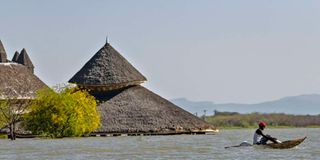A great rift between swelling lakes and the people

What you need to know:
- All the Rift Valley lakes have registered significant biodiversity and socio-economic impacts on vegetation, wildlife and communities living in these areas.
- There has been destruction of livelihoods and amenities including basic infrastructure like roads, schools, health centres, hospitality facilities, and fish handling facilities at fish landing sites.
An estimated 75,987 households with a total of 379,935 people are now at risk due to the rising waters of Rift Valley lakes in Kenya, a new survey indicates.
The study, Rising Water Levels in Kenya’s Rift Valley Lakes, Turkwel Gorge Dam and Lake Victoria, A Scoping Report, conducted by the Kenyan government in collaboration with the United Nations Development Programme (UNDP), singles out climate change as the major cause of swelling water levels in the lakes.
The lakes, which include Victoria, Turkana, Baringo, Bogoria, Nakuru, Elmenteita, Naivasha, Magadi, Solai, Ol’Bolossat, Logipi and Turkwell Dam, have also seen a rise in water levels due to tectonic movements, according to the report.
All the Rift Valley lakes have registered significant biodiversity and socio-economic impacts on vegetation, wildlife and communities living in these areas.
There has been destruction of livelihoods and amenities including basic infrastructure like roads, schools, health centres, hospitality facilities, and fish handling facilities at fish landing sites.
“The rising lake water levels and accompanying flooding have stirred panic and anxiety among the surrounding communities where the floodwaters have left trails of destruction and rendered hundreds of families homeless,” says Environment and Forestry Cabinet Secretary Keriako Tobiko.
He adds that there has been consequential loss of crops, farmland and pasture. “The wildlife was not spared either as the loss of grazing land drove them to higher grounds where displaced families had also sought refuge and hence leading to human-wildlife conflict,” he says.
The residents of Partalo, Ilgurme and Nosidan villages, the study says, increasingly feel insecure after the rising water levels pushed them out of their ancestral land onto other people’s territories where they are now competing for pasture.
As for human-wildlife conflict, most lake basins reported increased incidences of human-wildlife conflicts, particularly those involving animals like buffalos, hippos, crocodiles and snakes which moved closer to the villages, hence posing a threat to communities and their livestock.
“When Lake Baringo, Bogoria and Rukos Island wildlife sanctuary were submerged, wildlife had to relocate. Also submerged in the area were a GSU-RDU camp, KEMFRI labs, the Fisheries department, and other government and private facilities including hotels.”
In the Lake Magadi basin, security issues revolve around loss of lives and livestock due to flash floods, exposed fault lines and sinkholes in Nairage Enkare.
“There is unease within the Purko pastoral community over the construction of the silt diversion dykes and vandalism of galvanised steel wires that support the gabions at the diversion point for own use.”
In the Turkwel Dam area, there has been increased tension between Pokot and Turkana communities due to loss of grazing lands and lack of awareness of the dam operation mechanisms, especially the concern over the potential of dam spillage downstream.
The destruction of many hospitality facilities and tourist attraction areas has also been witnessed, with the rising water levels aiding the spread of invasive aquatic weeds like water hyacinth into previously unaffected wetlands.
“To be sure, the very phenomenon of rising water levels that has led to the destruction of livelihoods and biodiversity is not new in Kenya. Since more than a decade ago, we have all been witness to heavy and unusual rainfall patterns or other extreme weather events whose impacts are serious and far reaching,” says UNDP Resident Representative Walid Badawi.
But there are simmering legal challenges due to loss of about 1,106 square kilometres of land within and adjacent to the lakes. Part of the land that has been submerged has legal title deeds to it, implying that the holders have genuine grievances that will need to be addressed.
“Given the magnitude and the impact of rising lake water levels on livelihoods, the government urgently requires bilateral and multilateral agencies to support the design and implementation of a comprehensive programme that would safeguard the people and nature by enhancing community and ecosystem resilience,” says Dr Chris Kiptoo, Environment PS.
Some of the owners of lands that have been submerged, the study shows, had however encroached on riparian lands and will need to be moved to safer areas. The rich biodiversity areas including wildlife sanctuaries and key Ramsar sites in some of these counties have been greatly impacted. The areas around the lakes, which have been associated with a robust interplay of rich biodiversity of trees, shrubs and important habitat for animal species including numerous species of Kenya’s wildlife, have all been negatively impacted by the rising waters of the lakes.
“The ministry is fully committed to partner with stakeholders in the formulation and implementation of practical and long-term solutions to this phenomenon,” says Mr Tobiko.





